Cloud Computing Assignment Report - IaaS, SaaS, PaaS and Architectures
VerifiedAdded on 2020/03/02
|10
|2246
|76
Report
AI Summary
This assignment report delves into the realm of cloud computing, examining its core concepts and practical applications. It begins by defining cloud computing and its service models, including Infrastructure as a Service (IaaS), Software as a Service (SaaS), and Platform as a Service (PaaS), highlighting their distinct characteristics and benefits. The report then explores the advantages of cloud computing for businesses, such as cost savings, flexibility, and service automation. It further analyzes how a business can integrate Amazon Web Services (AWS) into its existing infrastructure using a hybrid model and discusses cloud bursting architecture. The report also explores the SaaS model, using email services as an example, and discusses the advantages and disadvantages of this model. The report then provides a detailed analysis of Microsoft Office 365 as a SaaS offering, highlighting its features and limitations. Finally, the report compares and contrasts the IaaS and PaaS models, outlining their pros and cons, and provides a recommendation based on their suitability for different business needs.
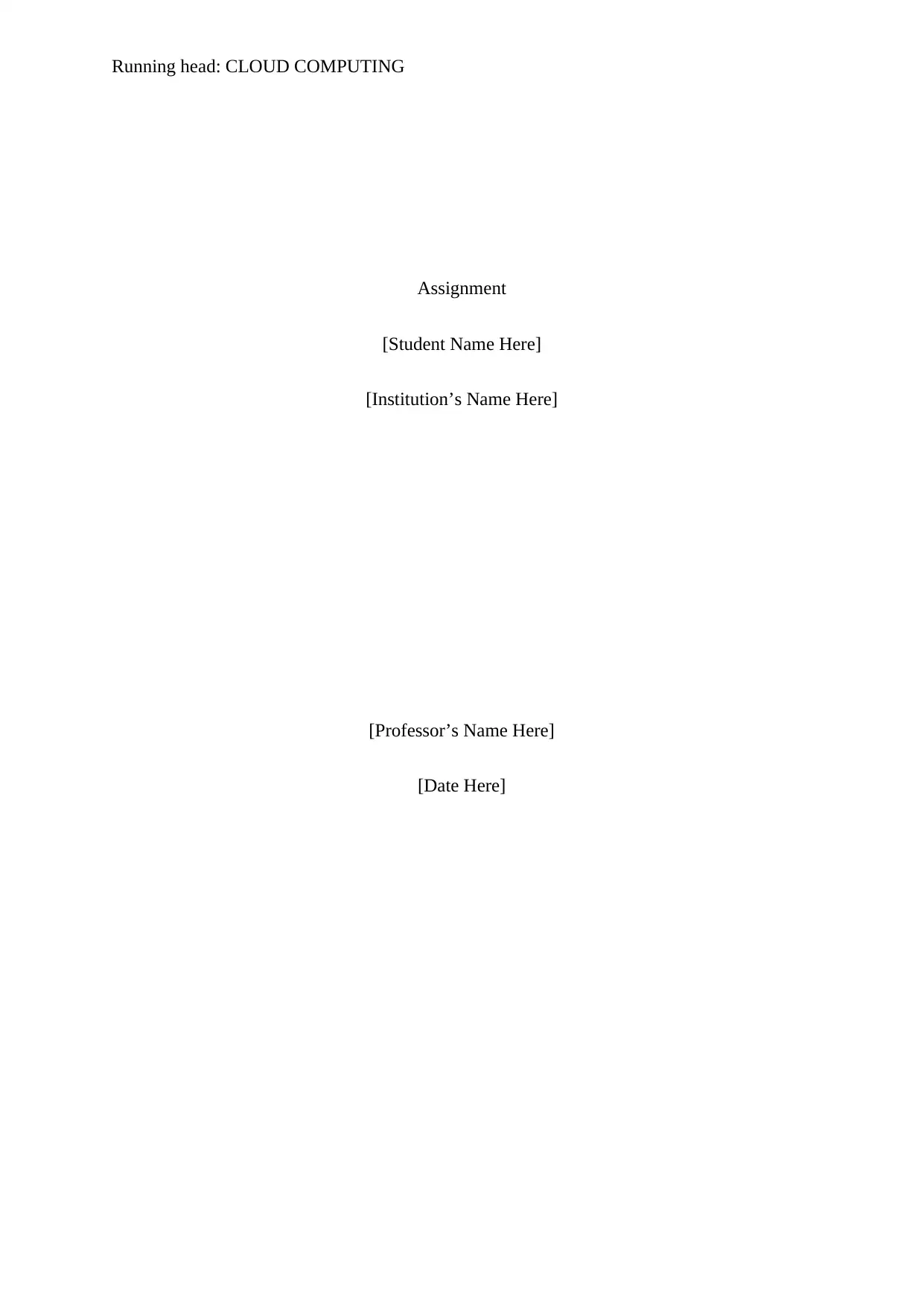
Running head: CLOUD COMPUTING
Assignment
[Student Name Here]
[Institution’s Name Here]
[Professor’s Name Here]
[Date Here]
Assignment
[Student Name Here]
[Institution’s Name Here]
[Professor’s Name Here]
[Date Here]
Paraphrase This Document
Need a fresh take? Get an instant paraphrase of this document with our AI Paraphraser
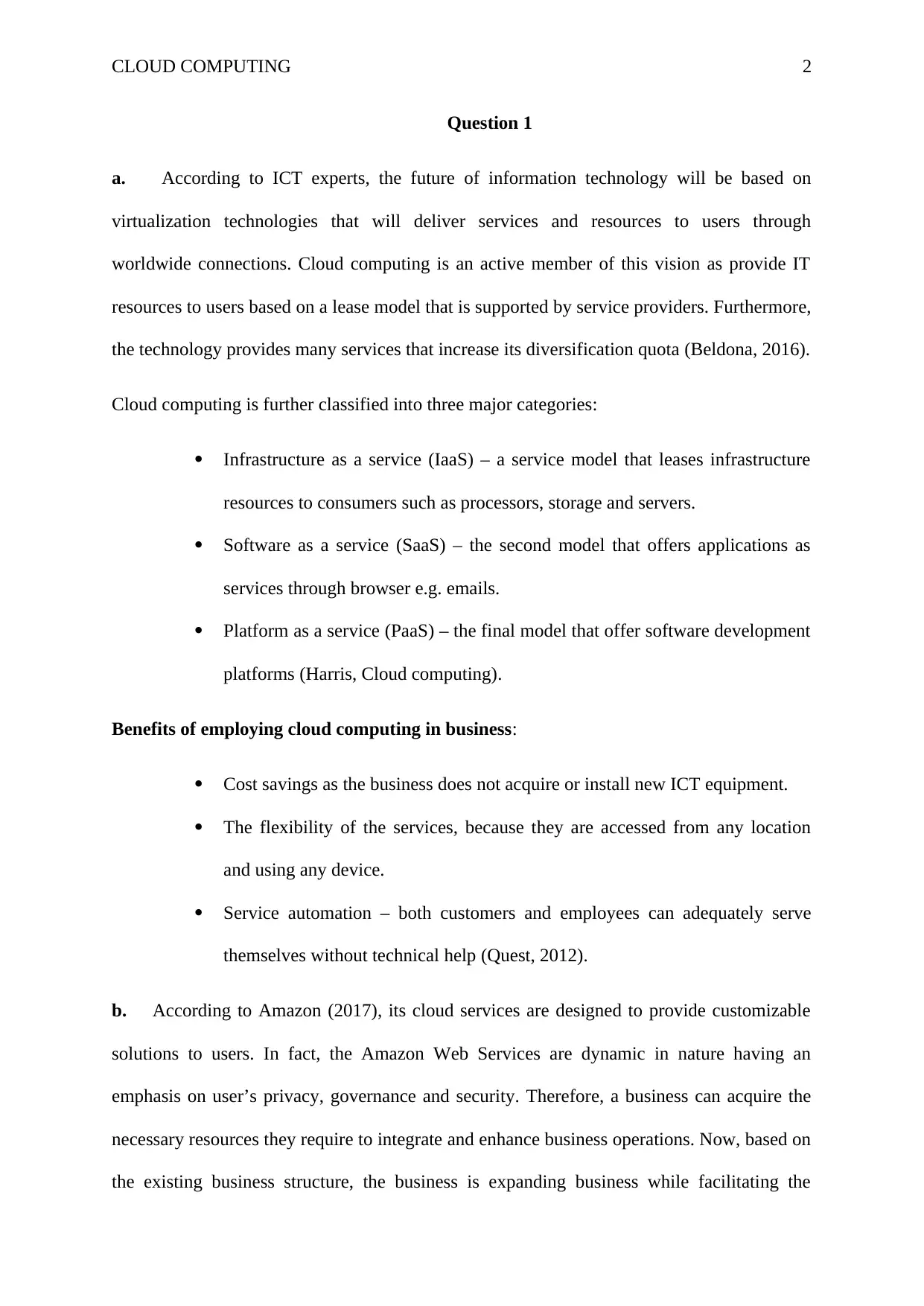
CLOUD COMPUTING 2
Question 1
a. According to ICT experts, the future of information technology will be based on
virtualization technologies that will deliver services and resources to users through
worldwide connections. Cloud computing is an active member of this vision as provide IT
resources to users based on a lease model that is supported by service providers. Furthermore,
the technology provides many services that increase its diversification quota (Beldona, 2016).
Cloud computing is further classified into three major categories:
Infrastructure as a service (IaaS) – a service model that leases infrastructure
resources to consumers such as processors, storage and servers.
Software as a service (SaaS) – the second model that offers applications as
services through browser e.g. emails.
Platform as a service (PaaS) – the final model that offer software development
platforms (Harris, Cloud computing).
Benefits of employing cloud computing in business:
Cost savings as the business does not acquire or install new ICT equipment.
The flexibility of the services, because they are accessed from any location
and using any device.
Service automation – both customers and employees can adequately serve
themselves without technical help (Quest, 2012).
b. According to Amazon (2017), its cloud services are designed to provide customizable
solutions to users. In fact, the Amazon Web Services are dynamic in nature having an
emphasis on user’s privacy, governance and security. Therefore, a business can acquire the
necessary resources they require to integrate and enhance business operations. Now, based on
the existing business structure, the business is expanding business while facilitating the
Question 1
a. According to ICT experts, the future of information technology will be based on
virtualization technologies that will deliver services and resources to users through
worldwide connections. Cloud computing is an active member of this vision as provide IT
resources to users based on a lease model that is supported by service providers. Furthermore,
the technology provides many services that increase its diversification quota (Beldona, 2016).
Cloud computing is further classified into three major categories:
Infrastructure as a service (IaaS) – a service model that leases infrastructure
resources to consumers such as processors, storage and servers.
Software as a service (SaaS) – the second model that offers applications as
services through browser e.g. emails.
Platform as a service (PaaS) – the final model that offer software development
platforms (Harris, Cloud computing).
Benefits of employing cloud computing in business:
Cost savings as the business does not acquire or install new ICT equipment.
The flexibility of the services, because they are accessed from any location
and using any device.
Service automation – both customers and employees can adequately serve
themselves without technical help (Quest, 2012).
b. According to Amazon (2017), its cloud services are designed to provide customizable
solutions to users. In fact, the Amazon Web Services are dynamic in nature having an
emphasis on user’s privacy, governance and security. Therefore, a business can acquire the
necessary resources they require to integrate and enhance business operations. Now, based on
the existing business structure, the business is expanding business while facilitating the
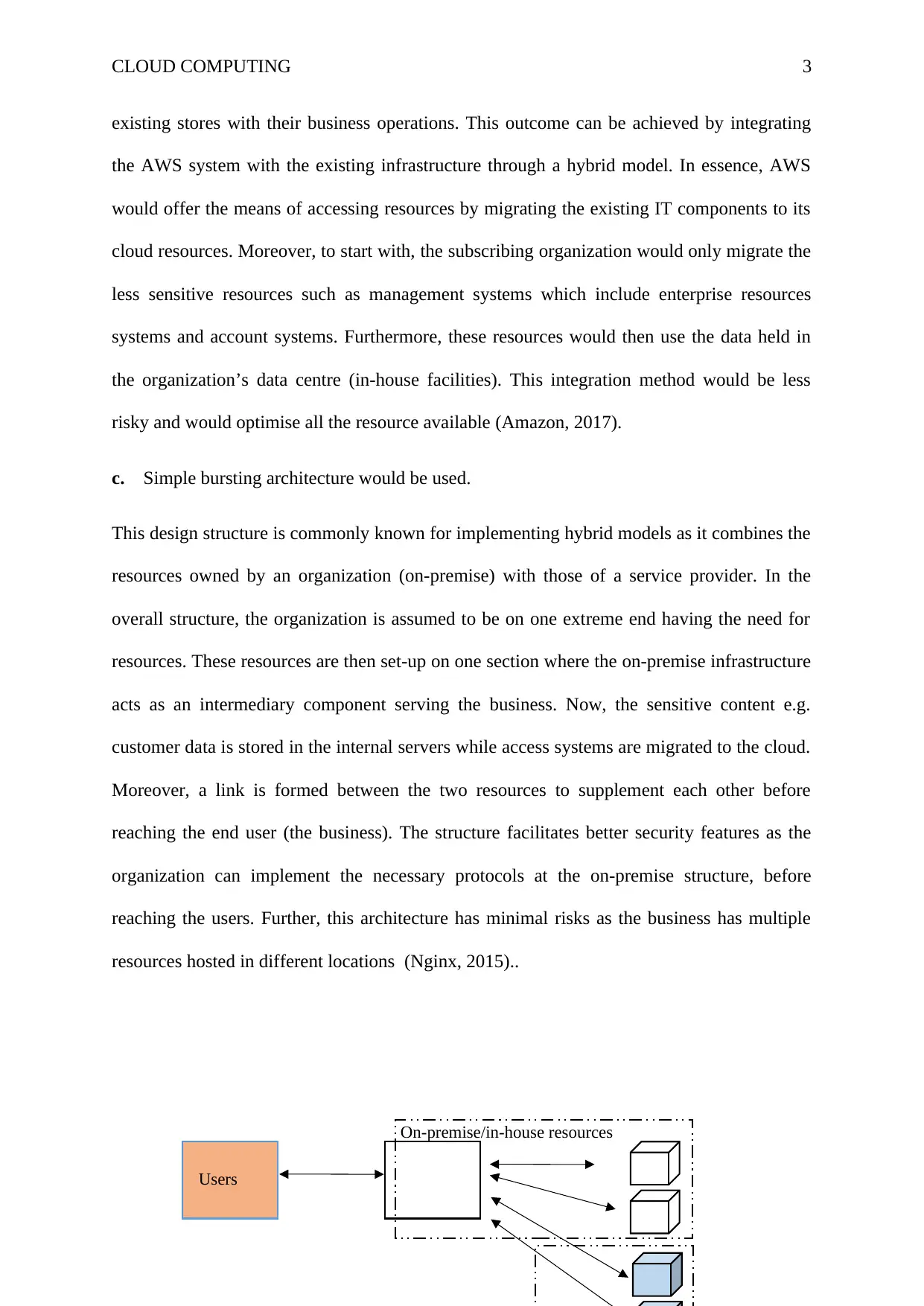
CLOUD COMPUTING 3
existing stores with their business operations. This outcome can be achieved by integrating
the AWS system with the existing infrastructure through a hybrid model. In essence, AWS
would offer the means of accessing resources by migrating the existing IT components to its
cloud resources. Moreover, to start with, the subscribing organization would only migrate the
less sensitive resources such as management systems which include enterprise resources
systems and account systems. Furthermore, these resources would then use the data held in
the organization’s data centre (in-house facilities). This integration method would be less
risky and would optimise all the resource available (Amazon, 2017).
c. Simple bursting architecture would be used.
This design structure is commonly known for implementing hybrid models as it combines the
resources owned by an organization (on-premise) with those of a service provider. In the
overall structure, the organization is assumed to be on one extreme end having the need for
resources. These resources are then set-up on one section where the on-premise infrastructure
acts as an intermediary component serving the business. Now, the sensitive content e.g.
customer data is stored in the internal servers while access systems are migrated to the cloud.
Moreover, a link is formed between the two resources to supplement each other before
reaching the end user (the business). The structure facilitates better security features as the
organization can implement the necessary protocols at the on-premise structure, before
reaching the users. Further, this architecture has minimal risks as the business has multiple
resources hosted in different locations (Nginx, 2015)..
On-premise/in-house resources
Users
existing stores with their business operations. This outcome can be achieved by integrating
the AWS system with the existing infrastructure through a hybrid model. In essence, AWS
would offer the means of accessing resources by migrating the existing IT components to its
cloud resources. Moreover, to start with, the subscribing organization would only migrate the
less sensitive resources such as management systems which include enterprise resources
systems and account systems. Furthermore, these resources would then use the data held in
the organization’s data centre (in-house facilities). This integration method would be less
risky and would optimise all the resource available (Amazon, 2017).
c. Simple bursting architecture would be used.
This design structure is commonly known for implementing hybrid models as it combines the
resources owned by an organization (on-premise) with those of a service provider. In the
overall structure, the organization is assumed to be on one extreme end having the need for
resources. These resources are then set-up on one section where the on-premise infrastructure
acts as an intermediary component serving the business. Now, the sensitive content e.g.
customer data is stored in the internal servers while access systems are migrated to the cloud.
Moreover, a link is formed between the two resources to supplement each other before
reaching the end user (the business). The structure facilitates better security features as the
organization can implement the necessary protocols at the on-premise structure, before
reaching the users. Further, this architecture has minimal risks as the business has multiple
resources hosted in different locations (Nginx, 2015)..
On-premise/in-house resources
Users
⊘ This is a preview!⊘
Do you want full access?
Subscribe today to unlock all pages.

Trusted by 1+ million students worldwide
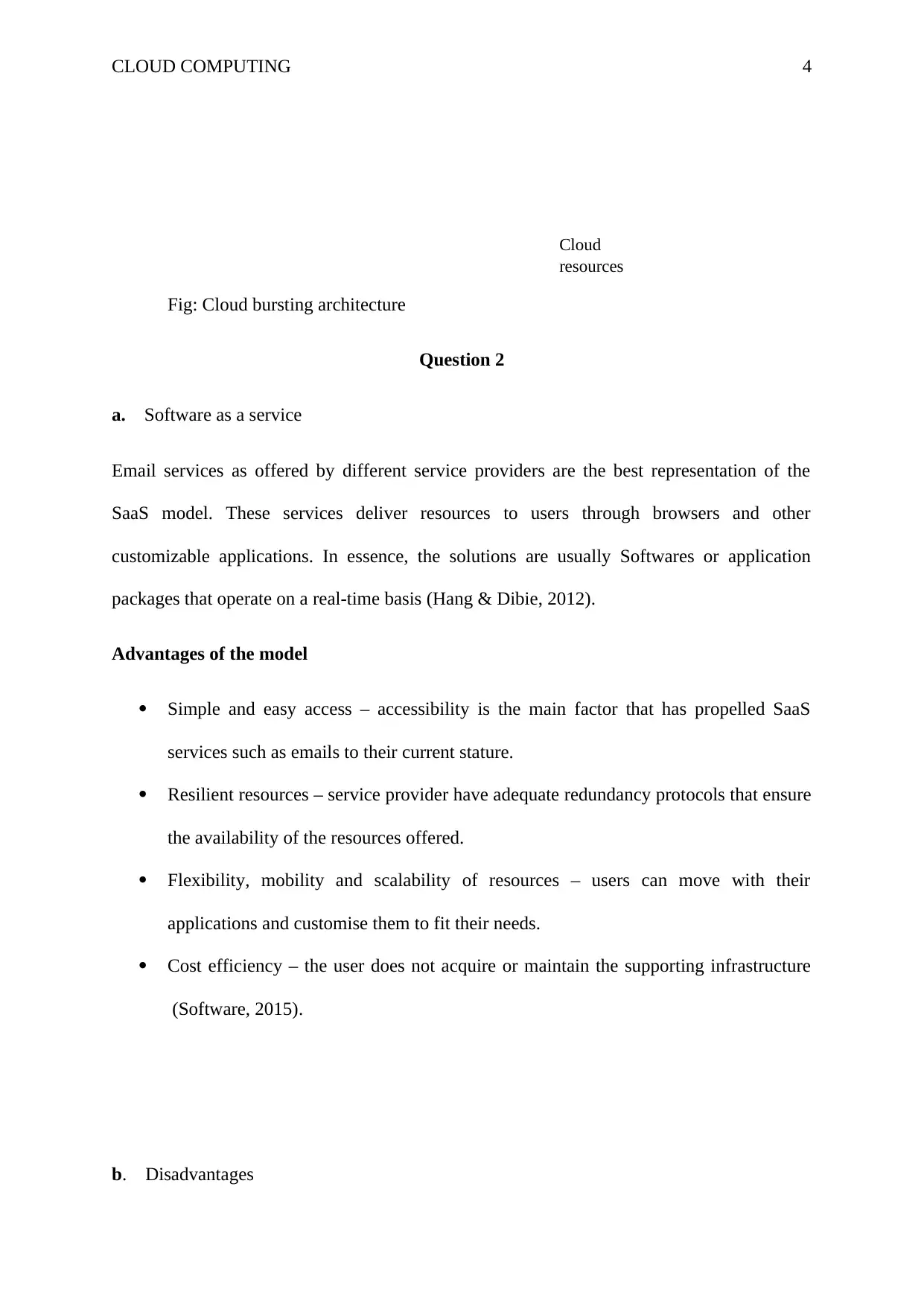
CLOUD COMPUTING 4
Fig: Cloud bursting architecture
Question 2
a. Software as a service
Email services as offered by different service providers are the best representation of the
SaaS model. These services deliver resources to users through browsers and other
customizable applications. In essence, the solutions are usually Softwares or application
packages that operate on a real-time basis (Hang & Dibie, 2012).
Advantages of the model
Simple and easy access – accessibility is the main factor that has propelled SaaS
services such as emails to their current stature.
Resilient resources – service provider have adequate redundancy protocols that ensure
the availability of the resources offered.
Flexibility, mobility and scalability of resources – users can move with their
applications and customise them to fit their needs.
Cost efficiency – the user does not acquire or maintain the supporting infrastructure
(Software, 2015).
b. Disadvantages
Cloud
resources
Fig: Cloud bursting architecture
Question 2
a. Software as a service
Email services as offered by different service providers are the best representation of the
SaaS model. These services deliver resources to users through browsers and other
customizable applications. In essence, the solutions are usually Softwares or application
packages that operate on a real-time basis (Hang & Dibie, 2012).
Advantages of the model
Simple and easy access – accessibility is the main factor that has propelled SaaS
services such as emails to their current stature.
Resilient resources – service provider have adequate redundancy protocols that ensure
the availability of the resources offered.
Flexibility, mobility and scalability of resources – users can move with their
applications and customise them to fit their needs.
Cost efficiency – the user does not acquire or maintain the supporting infrastructure
(Software, 2015).
b. Disadvantages
Cloud
resources
Paraphrase This Document
Need a fresh take? Get an instant paraphrase of this document with our AI Paraphraser
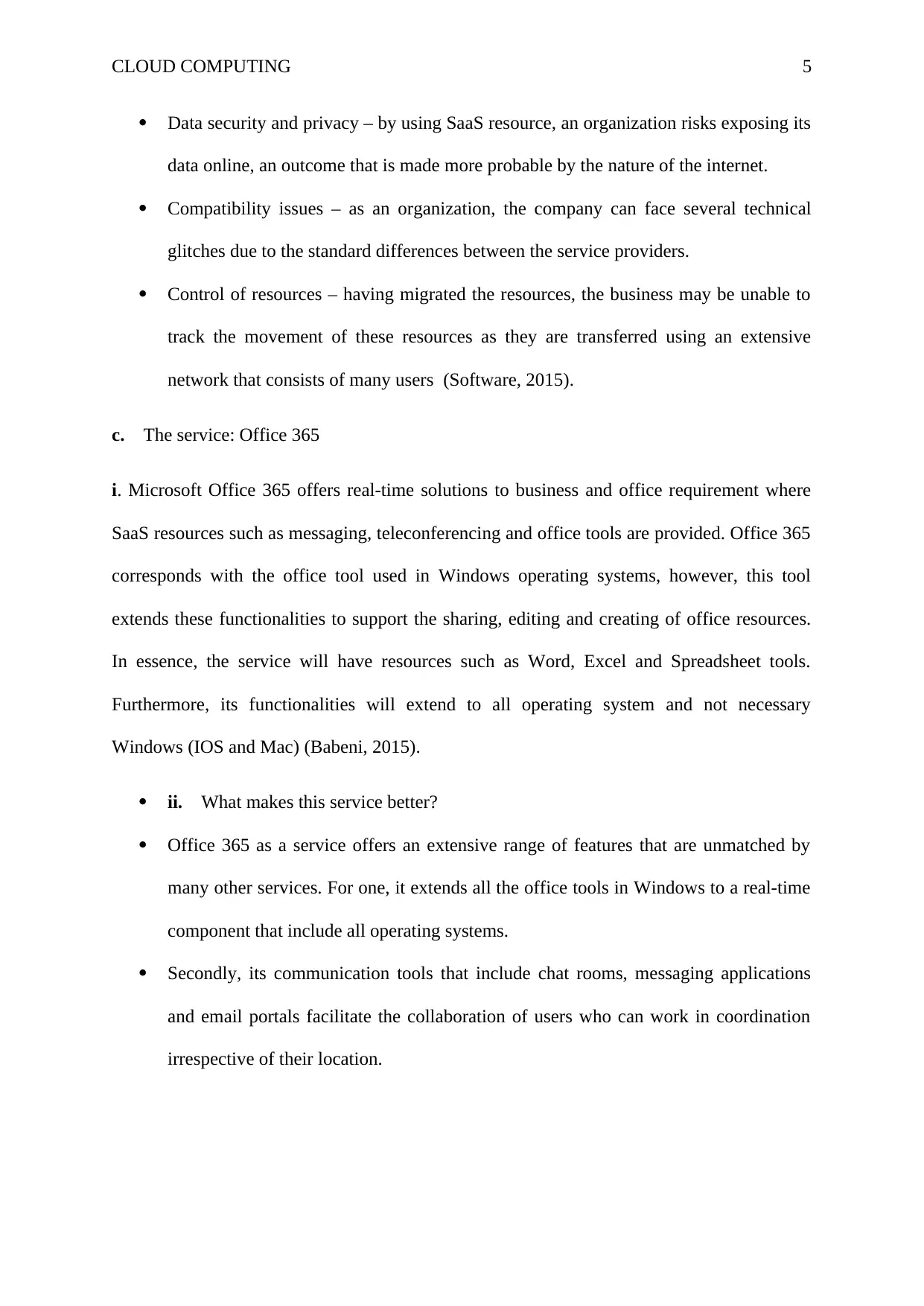
CLOUD COMPUTING 5
Data security and privacy – by using SaaS resource, an organization risks exposing its
data online, an outcome that is made more probable by the nature of the internet.
Compatibility issues – as an organization, the company can face several technical
glitches due to the standard differences between the service providers.
Control of resources – having migrated the resources, the business may be unable to
track the movement of these resources as they are transferred using an extensive
network that consists of many users (Software, 2015).
c. The service: Office 365
i. Microsoft Office 365 offers real-time solutions to business and office requirement where
SaaS resources such as messaging, teleconferencing and office tools are provided. Office 365
corresponds with the office tool used in Windows operating systems, however, this tool
extends these functionalities to support the sharing, editing and creating of office resources.
In essence, the service will have resources such as Word, Excel and Spreadsheet tools.
Furthermore, its functionalities will extend to all operating system and not necessary
Windows (IOS and Mac) (Babeni, 2015).
ii. What makes this service better?
Office 365 as a service offers an extensive range of features that are unmatched by
many other services. For one, it extends all the office tools in Windows to a real-time
component that include all operating systems.
Secondly, its communication tools that include chat rooms, messaging applications
and email portals facilitate the collaboration of users who can work in coordination
irrespective of their location.
Data security and privacy – by using SaaS resource, an organization risks exposing its
data online, an outcome that is made more probable by the nature of the internet.
Compatibility issues – as an organization, the company can face several technical
glitches due to the standard differences between the service providers.
Control of resources – having migrated the resources, the business may be unable to
track the movement of these resources as they are transferred using an extensive
network that consists of many users (Software, 2015).
c. The service: Office 365
i. Microsoft Office 365 offers real-time solutions to business and office requirement where
SaaS resources such as messaging, teleconferencing and office tools are provided. Office 365
corresponds with the office tool used in Windows operating systems, however, this tool
extends these functionalities to support the sharing, editing and creating of office resources.
In essence, the service will have resources such as Word, Excel and Spreadsheet tools.
Furthermore, its functionalities will extend to all operating system and not necessary
Windows (IOS and Mac) (Babeni, 2015).
ii. What makes this service better?
Office 365 as a service offers an extensive range of features that are unmatched by
many other services. For one, it extends all the office tools in Windows to a real-time
component that include all operating systems.
Secondly, its communication tools that include chat rooms, messaging applications
and email portals facilitate the collaboration of users who can work in coordination
irrespective of their location.
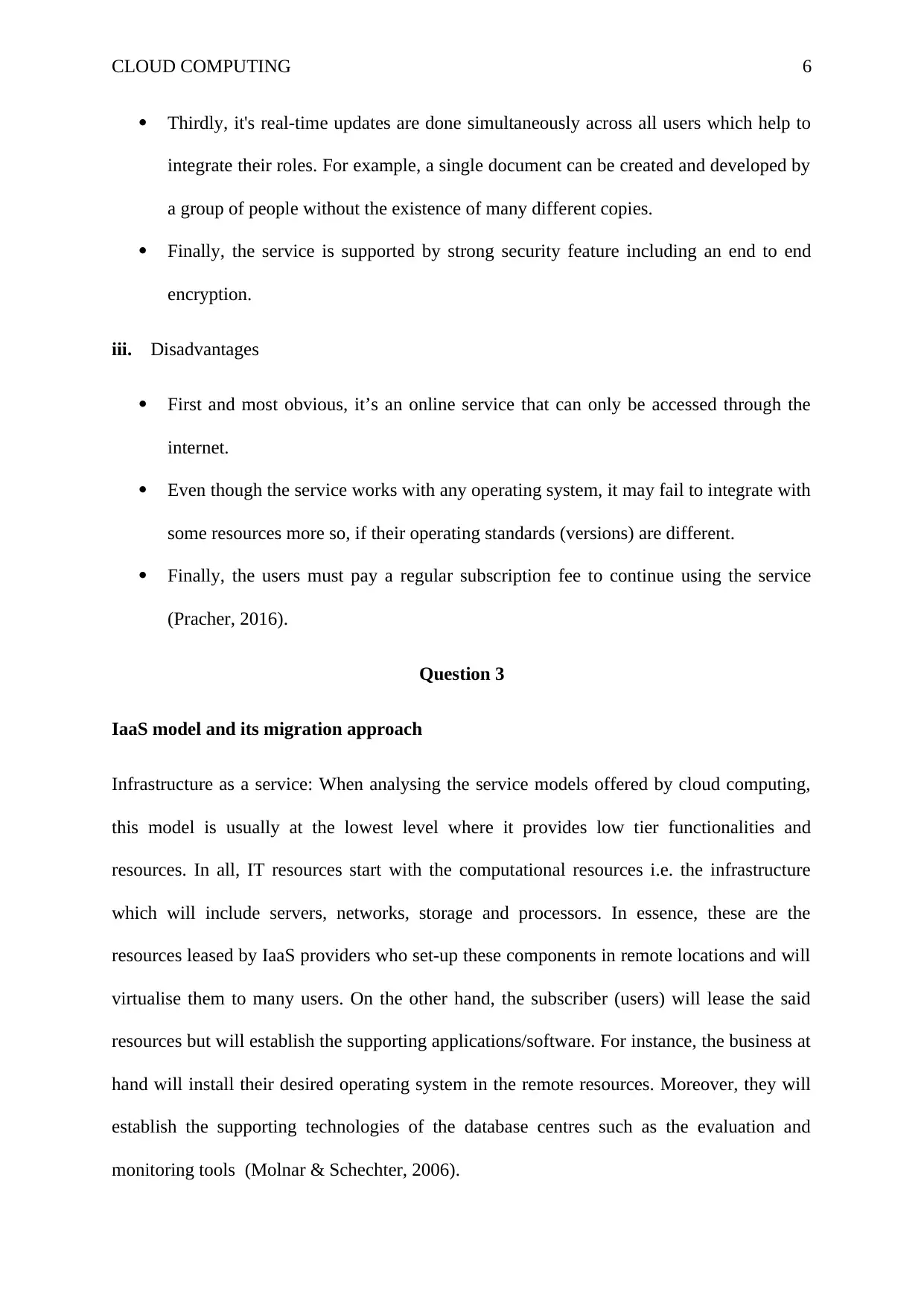
CLOUD COMPUTING 6
Thirdly, it's real-time updates are done simultaneously across all users which help to
integrate their roles. For example, a single document can be created and developed by
a group of people without the existence of many different copies.
Finally, the service is supported by strong security feature including an end to end
encryption.
iii. Disadvantages
First and most obvious, it’s an online service that can only be accessed through the
internet.
Even though the service works with any operating system, it may fail to integrate with
some resources more so, if their operating standards (versions) are different.
Finally, the users must pay a regular subscription fee to continue using the service
(Pracher, 2016).
Question 3
IaaS model and its migration approach
Infrastructure as a service: When analysing the service models offered by cloud computing,
this model is usually at the lowest level where it provides low tier functionalities and
resources. In all, IT resources start with the computational resources i.e. the infrastructure
which will include servers, networks, storage and processors. In essence, these are the
resources leased by IaaS providers who set-up these components in remote locations and will
virtualise them to many users. On the other hand, the subscriber (users) will lease the said
resources but will establish the supporting applications/software. For instance, the business at
hand will install their desired operating system in the remote resources. Moreover, they will
establish the supporting technologies of the database centres such as the evaluation and
monitoring tools (Molnar & Schechter, 2006).
Thirdly, it's real-time updates are done simultaneously across all users which help to
integrate their roles. For example, a single document can be created and developed by
a group of people without the existence of many different copies.
Finally, the service is supported by strong security feature including an end to end
encryption.
iii. Disadvantages
First and most obvious, it’s an online service that can only be accessed through the
internet.
Even though the service works with any operating system, it may fail to integrate with
some resources more so, if their operating standards (versions) are different.
Finally, the users must pay a regular subscription fee to continue using the service
(Pracher, 2016).
Question 3
IaaS model and its migration approach
Infrastructure as a service: When analysing the service models offered by cloud computing,
this model is usually at the lowest level where it provides low tier functionalities and
resources. In all, IT resources start with the computational resources i.e. the infrastructure
which will include servers, networks, storage and processors. In essence, these are the
resources leased by IaaS providers who set-up these components in remote locations and will
virtualise them to many users. On the other hand, the subscriber (users) will lease the said
resources but will establish the supporting applications/software. For instance, the business at
hand will install their desired operating system in the remote resources. Moreover, they will
establish the supporting technologies of the database centres such as the evaluation and
monitoring tools (Molnar & Schechter, 2006).
⊘ This is a preview!⊘
Do you want full access?
Subscribe today to unlock all pages.

Trusted by 1+ million students worldwide
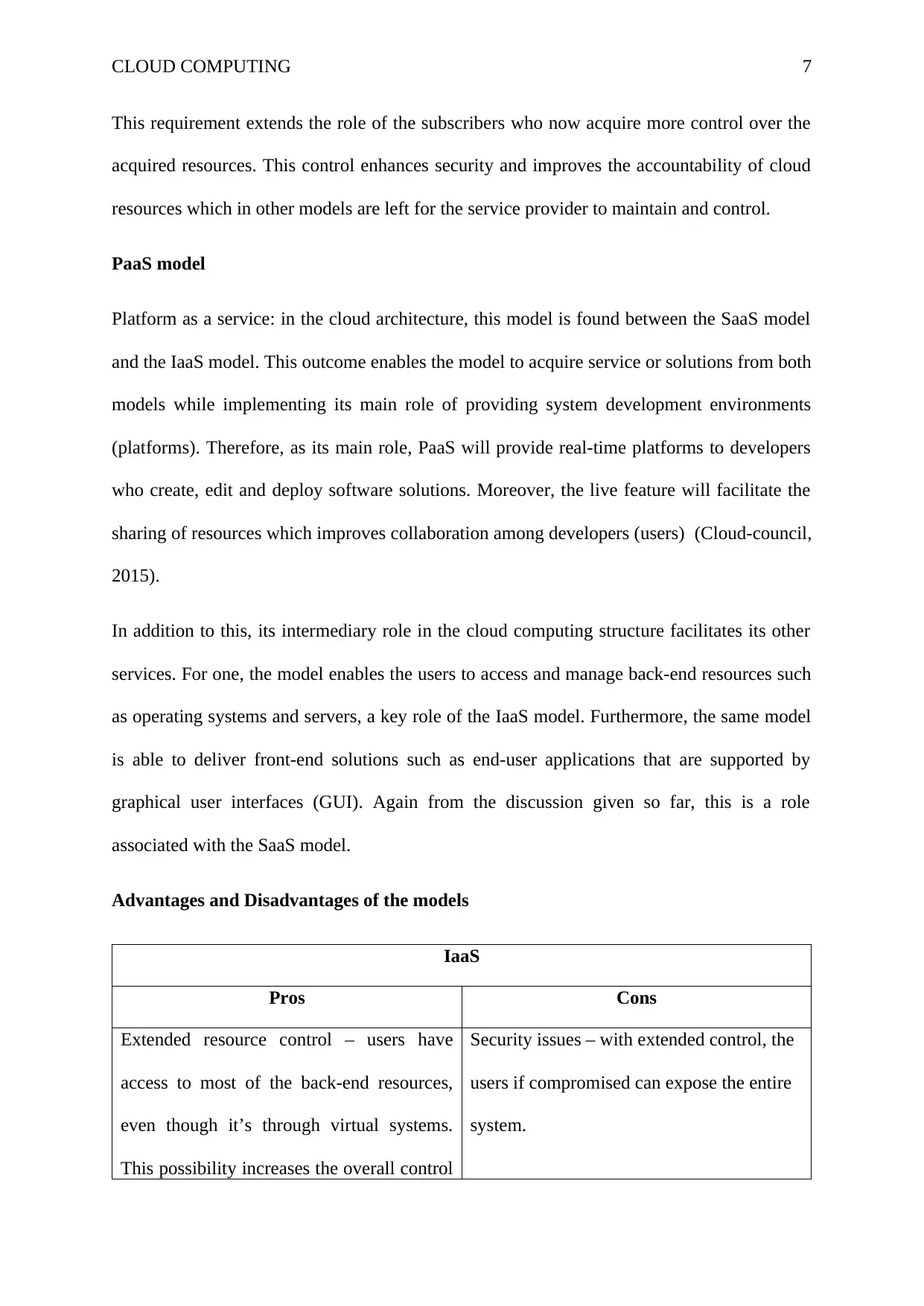
CLOUD COMPUTING 7
This requirement extends the role of the subscribers who now acquire more control over the
acquired resources. This control enhances security and improves the accountability of cloud
resources which in other models are left for the service provider to maintain and control.
PaaS model
Platform as a service: in the cloud architecture, this model is found between the SaaS model
and the IaaS model. This outcome enables the model to acquire service or solutions from both
models while implementing its main role of providing system development environments
(platforms). Therefore, as its main role, PaaS will provide real-time platforms to developers
who create, edit and deploy software solutions. Moreover, the live feature will facilitate the
sharing of resources which improves collaboration among developers (users) (Cloud-council,
2015).
In addition to this, its intermediary role in the cloud computing structure facilitates its other
services. For one, the model enables the users to access and manage back-end resources such
as operating systems and servers, a key role of the IaaS model. Furthermore, the same model
is able to deliver front-end solutions such as end-user applications that are supported by
graphical user interfaces (GUI). Again from the discussion given so far, this is a role
associated with the SaaS model.
Advantages and Disadvantages of the models
IaaS
Pros Cons
Extended resource control – users have
access to most of the back-end resources,
even though it’s through virtual systems.
This possibility increases the overall control
Security issues – with extended control, the
users if compromised can expose the entire
system.
This requirement extends the role of the subscribers who now acquire more control over the
acquired resources. This control enhances security and improves the accountability of cloud
resources which in other models are left for the service provider to maintain and control.
PaaS model
Platform as a service: in the cloud architecture, this model is found between the SaaS model
and the IaaS model. This outcome enables the model to acquire service or solutions from both
models while implementing its main role of providing system development environments
(platforms). Therefore, as its main role, PaaS will provide real-time platforms to developers
who create, edit and deploy software solutions. Moreover, the live feature will facilitate the
sharing of resources which improves collaboration among developers (users) (Cloud-council,
2015).
In addition to this, its intermediary role in the cloud computing structure facilitates its other
services. For one, the model enables the users to access and manage back-end resources such
as operating systems and servers, a key role of the IaaS model. Furthermore, the same model
is able to deliver front-end solutions such as end-user applications that are supported by
graphical user interfaces (GUI). Again from the discussion given so far, this is a role
associated with the SaaS model.
Advantages and Disadvantages of the models
IaaS
Pros Cons
Extended resource control – users have
access to most of the back-end resources,
even though it’s through virtual systems.
This possibility increases the overall control
Security issues – with extended control, the
users if compromised can expose the entire
system.
Paraphrase This Document
Need a fresh take? Get an instant paraphrase of this document with our AI Paraphraser
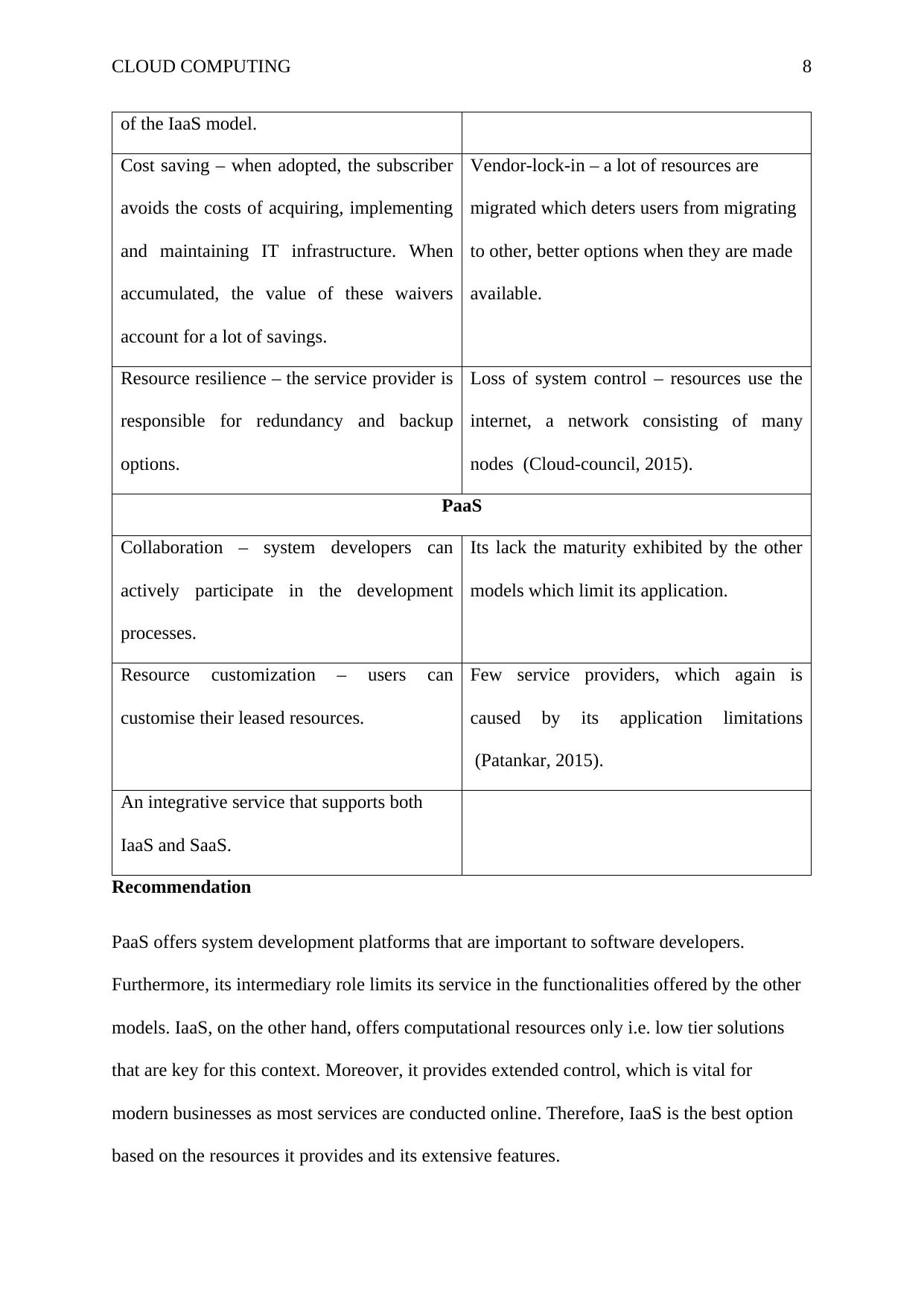
CLOUD COMPUTING 8
of the IaaS model.
Cost saving – when adopted, the subscriber
avoids the costs of acquiring, implementing
and maintaining IT infrastructure. When
accumulated, the value of these waivers
account for a lot of savings.
Vendor-lock-in – a lot of resources are
migrated which deters users from migrating
to other, better options when they are made
available.
Resource resilience – the service provider is
responsible for redundancy and backup
options.
Loss of system control – resources use the
internet, a network consisting of many
nodes (Cloud-council, 2015).
PaaS
Collaboration – system developers can
actively participate in the development
processes.
Its lack the maturity exhibited by the other
models which limit its application.
Resource customization – users can
customise their leased resources.
Few service providers, which again is
caused by its application limitations
(Patankar, 2015).
An integrative service that supports both
IaaS and SaaS.
Recommendation
PaaS offers system development platforms that are important to software developers.
Furthermore, its intermediary role limits its service in the functionalities offered by the other
models. IaaS, on the other hand, offers computational resources only i.e. low tier solutions
that are key for this context. Moreover, it provides extended control, which is vital for
modern businesses as most services are conducted online. Therefore, IaaS is the best option
based on the resources it provides and its extensive features.
of the IaaS model.
Cost saving – when adopted, the subscriber
avoids the costs of acquiring, implementing
and maintaining IT infrastructure. When
accumulated, the value of these waivers
account for a lot of savings.
Vendor-lock-in – a lot of resources are
migrated which deters users from migrating
to other, better options when they are made
available.
Resource resilience – the service provider is
responsible for redundancy and backup
options.
Loss of system control – resources use the
internet, a network consisting of many
nodes (Cloud-council, 2015).
PaaS
Collaboration – system developers can
actively participate in the development
processes.
Its lack the maturity exhibited by the other
models which limit its application.
Resource customization – users can
customise their leased resources.
Few service providers, which again is
caused by its application limitations
(Patankar, 2015).
An integrative service that supports both
IaaS and SaaS.
Recommendation
PaaS offers system development platforms that are important to software developers.
Furthermore, its intermediary role limits its service in the functionalities offered by the other
models. IaaS, on the other hand, offers computational resources only i.e. low tier solutions
that are key for this context. Moreover, it provides extended control, which is vital for
modern businesses as most services are conducted online. Therefore, IaaS is the best option
based on the resources it provides and its extensive features.
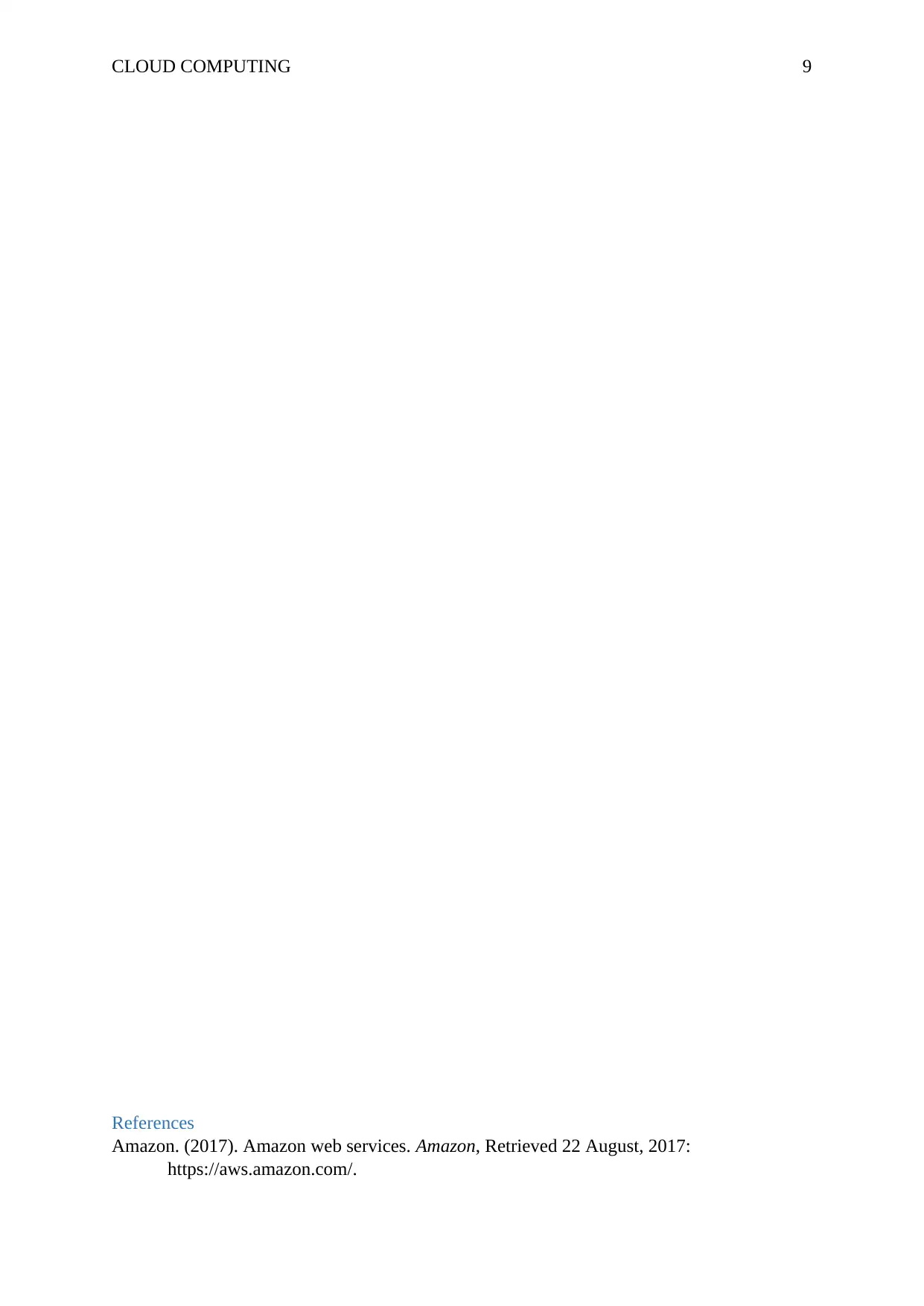
CLOUD COMPUTING 9
References
Amazon. (2017). Amazon web services. Amazon, Retrieved 22 August, 2017:
https://aws.amazon.com/.
References
Amazon. (2017). Amazon web services. Amazon, Retrieved 22 August, 2017:
https://aws.amazon.com/.
⊘ This is a preview!⊘
Do you want full access?
Subscribe today to unlock all pages.

Trusted by 1+ million students worldwide
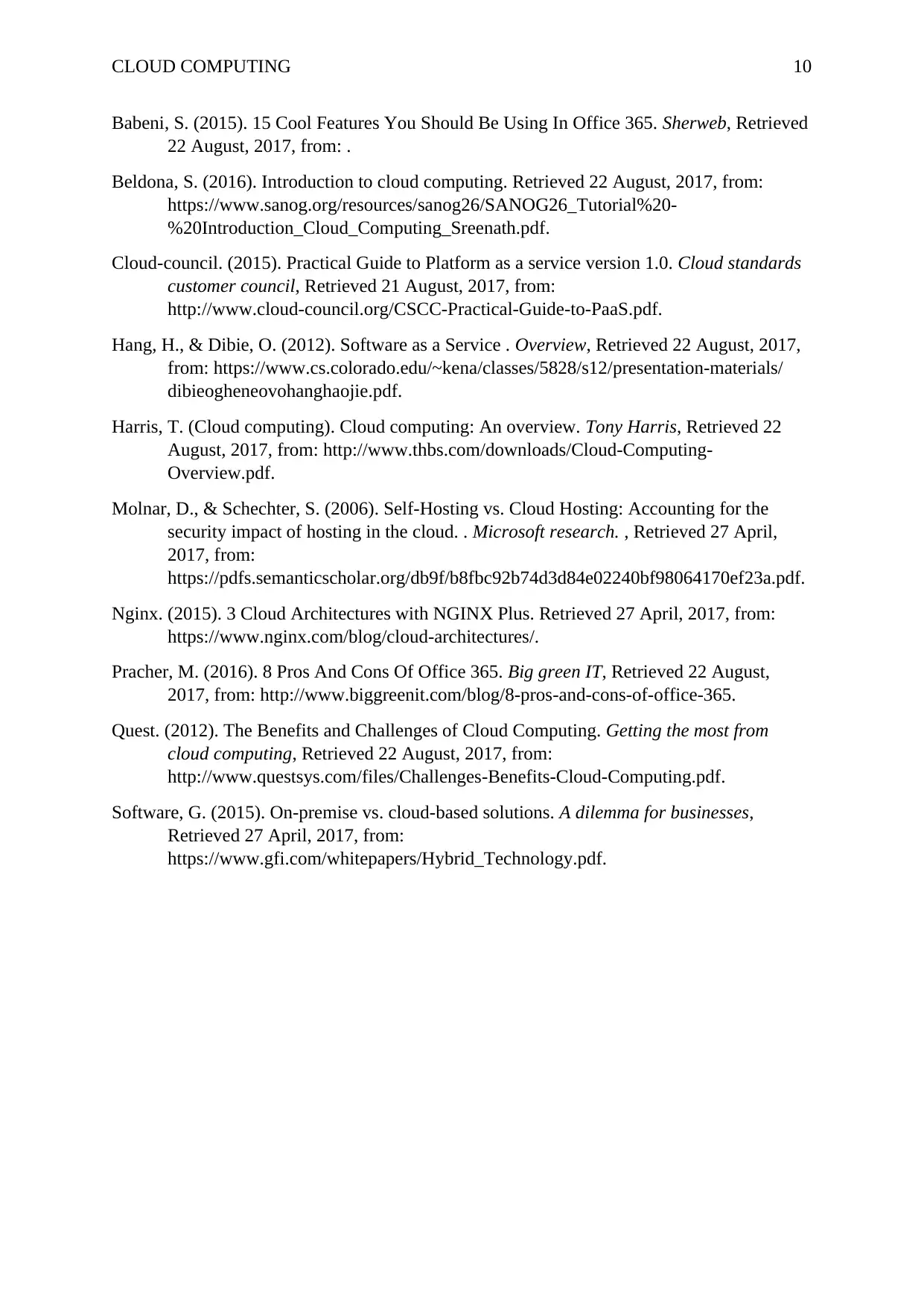
CLOUD COMPUTING 10
Babeni, S. (2015). 15 Cool Features You Should Be Using In Office 365. Sherweb, Retrieved
22 August, 2017, from: .
Beldona, S. (2016). Introduction to cloud computing. Retrieved 22 August, 2017, from:
https://www.sanog.org/resources/sanog26/SANOG26_Tutorial%20-
%20Introduction_Cloud_Computing_Sreenath.pdf.
Cloud-council. (2015). Practical Guide to Platform as a service version 1.0. Cloud standards
customer council, Retrieved 21 August, 2017, from:
http://www.cloud-council.org/CSCC-Practical-Guide-to-PaaS.pdf.
Hang, H., & Dibie, O. (2012). Software as a Service . Overview, Retrieved 22 August, 2017,
from: https://www.cs.colorado.edu/~kena/classes/5828/s12/presentation-materials/
dibieogheneovohanghaojie.pdf.
Harris, T. (Cloud computing). Cloud computing: An overview. Tony Harris, Retrieved 22
August, 2017, from: http://www.thbs.com/downloads/Cloud-Computing-
Overview.pdf.
Molnar, D., & Schechter, S. (2006). Self-Hosting vs. Cloud Hosting: Accounting for the
security impact of hosting in the cloud. . Microsoft research. , Retrieved 27 April,
2017, from:
https://pdfs.semanticscholar.org/db9f/b8fbc92b74d3d84e02240bf98064170ef23a.pdf.
Nginx. (2015). 3 Cloud Architectures with NGINX Plus. Retrieved 27 April, 2017, from:
https://www.nginx.com/blog/cloud-architectures/.
Pracher, M. (2016). 8 Pros And Cons Of Office 365. Big green IT, Retrieved 22 August,
2017, from: http://www.biggreenit.com/blog/8-pros-and-cons-of-office-365.
Quest. (2012). The Benefits and Challenges of Cloud Computing. Getting the most from
cloud computing, Retrieved 22 August, 2017, from:
http://www.questsys.com/files/Challenges-Benefits-Cloud-Computing.pdf.
Software, G. (2015). On-premise vs. cloud-based solutions. A dilemma for businesses,
Retrieved 27 April, 2017, from:
https://www.gfi.com/whitepapers/Hybrid_Technology.pdf.
Babeni, S. (2015). 15 Cool Features You Should Be Using In Office 365. Sherweb, Retrieved
22 August, 2017, from: .
Beldona, S. (2016). Introduction to cloud computing. Retrieved 22 August, 2017, from:
https://www.sanog.org/resources/sanog26/SANOG26_Tutorial%20-
%20Introduction_Cloud_Computing_Sreenath.pdf.
Cloud-council. (2015). Practical Guide to Platform as a service version 1.0. Cloud standards
customer council, Retrieved 21 August, 2017, from:
http://www.cloud-council.org/CSCC-Practical-Guide-to-PaaS.pdf.
Hang, H., & Dibie, O. (2012). Software as a Service . Overview, Retrieved 22 August, 2017,
from: https://www.cs.colorado.edu/~kena/classes/5828/s12/presentation-materials/
dibieogheneovohanghaojie.pdf.
Harris, T. (Cloud computing). Cloud computing: An overview. Tony Harris, Retrieved 22
August, 2017, from: http://www.thbs.com/downloads/Cloud-Computing-
Overview.pdf.
Molnar, D., & Schechter, S. (2006). Self-Hosting vs. Cloud Hosting: Accounting for the
security impact of hosting in the cloud. . Microsoft research. , Retrieved 27 April,
2017, from:
https://pdfs.semanticscholar.org/db9f/b8fbc92b74d3d84e02240bf98064170ef23a.pdf.
Nginx. (2015). 3 Cloud Architectures with NGINX Plus. Retrieved 27 April, 2017, from:
https://www.nginx.com/blog/cloud-architectures/.
Pracher, M. (2016). 8 Pros And Cons Of Office 365. Big green IT, Retrieved 22 August,
2017, from: http://www.biggreenit.com/blog/8-pros-and-cons-of-office-365.
Quest. (2012). The Benefits and Challenges of Cloud Computing. Getting the most from
cloud computing, Retrieved 22 August, 2017, from:
http://www.questsys.com/files/Challenges-Benefits-Cloud-Computing.pdf.
Software, G. (2015). On-premise vs. cloud-based solutions. A dilemma for businesses,
Retrieved 27 April, 2017, from:
https://www.gfi.com/whitepapers/Hybrid_Technology.pdf.
1 out of 10
Related Documents
Your All-in-One AI-Powered Toolkit for Academic Success.
+13062052269
info@desklib.com
Available 24*7 on WhatsApp / Email
![[object Object]](/_next/static/media/star-bottom.7253800d.svg)
Unlock your academic potential
Copyright © 2020–2025 A2Z Services. All Rights Reserved. Developed and managed by ZUCOL.





